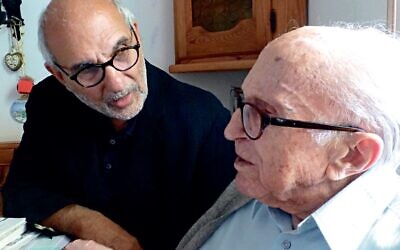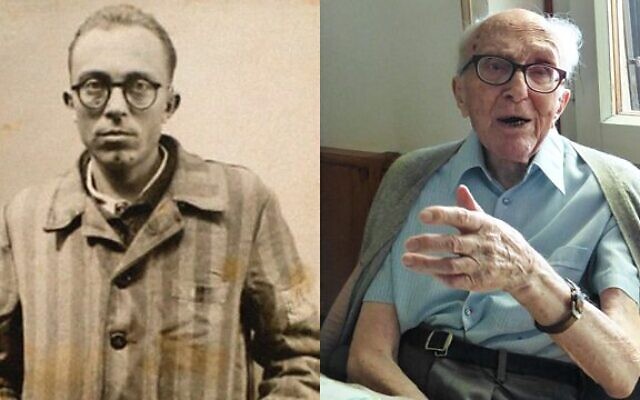Oldest Holocaust survivor, author Boris Pahor, dies aged 108
Pahor lived through spells at the Dachau, Mittelbau-Dora, Harzungen and Bergen-Belsen death camps, after being captured while fighting for the Slovene Partisans against the Nazi occupation in World War II.
The oldest Holocaust survivor Boris Pahor has died at the age of 108.
Pahor endured spells at the Dachau, Mittelbau-Dora, Harzungen and Bergen-Belsen death camps, after being captured while fighting for the Slovene Partisans against the Nazi occupation in World War II.
He was also held at Natzweiler-Struthof in France’s Alsace region, which held 52,000 for resistance work – just over half survived..
Pahor was best-known for ‘Necropolis’ (1967), an autobiographical novel translated the world over, and written after a visit to a Nazi camp where he had been held 20 years earlier.
It depicted the brutality and horror of what he had seen – and his guilt at surviving.
He was born on August 26, 1913, in what is now Italy’s northeastern coastal city of Trieste – which had been part of the Austro-Hungarian empire and home to a big Slovenian community.

The city became part of Italy in the post-World War I break-up of the defeated empire, and the Slovenes were banned from speaking their own language and subjected to a campaign of “Italianisation”. Names were Italianised. Slovenians were arrested, and resistors executed.
He realised s a teenager in Trieste he was one of the “bugs” that Mussolini wanted to crush and vowed loyalty to his Slovene identity.
“I started to put my identity on paper, to write about my street, the sea, the quays. I conquered the town in Slovene,” he said.
Pahor was arrested by the Nazis in 1944 for his involvement with the anti-fascist Slovenian resistance.
In a 2019 BBC documentary The Man Who Saw Too Much, he described being beaten by the Gestapo before being sent to Dachau.
“They started to beat me with leather straps – one on the right and one on the left – each with a whip, all over my body,” he said. “I was screaming. They didn’t care. They had the radio on. My back was like a zebra when I went back to the jail.
“But at least they didn’t use electricity. If they had, as they did with the Communists, I am not sure I could have kept silent.”
Pahor later in life stood for European and regional elections for the Slovene Union party, representing Italy’s Slovene minority – more than 80,000 people.
Pahor received Slovenia’s highest award for cultural achievement after it became independent from the disintegrating Yugoslavia in 1991, and was appointed to its Academy of Sciences and Arts.
“In this Europe, dominated by the economy, the minorities, their culture and their language do not have the place that they deserve,” he told AFP.
“I deal with the past because I am interested in the future. The past was bad and should not be repeated.
“Since I had come out of the concentration camps alive, I had become indifferent to the passage of time. I do not stop, I look ahead.”
Italian President Sergio Mattarella hailed Pahor as a “witness and victim of the horrors caused by war, by inflated nationalism and totalitarian ideologies”.
Italian Culture Minister Dario Franceschini said: “With the passing of Boris Pahor we have lost a great writer, a giant of the 20th century who was able to tell the horrors of the concentration camp with skill and clarity, pulling no punches.”

Thank you for helping to make Jewish News the leading source of news and opinion for the UK Jewish community. Today we're asking for your invaluable help to continue putting our community first in everything we do.
Unlike other Jewish media, we do not charge for content. That won’t change. Because we are free, we rely on advertising to cover our costs. This vital lifeline, which has dropped in recent years, has fallen further due to coronavirus.
For as little as £5 a month you can help sustain the vital work we do in celebrating and standing up for Jewish life in Britain.



 Rabbi Chait was told he would have to pay £10 to go on the Tour of the building but has since seen a video with treasured plaques, memorial stones and documentation discarded in store rooms.
Rabbi Chait was told he would have to pay £10 to go on the Tour of the building but has since seen a video with treasured plaques, memorial stones and documentation discarded in store rooms. Rabbi Benjamin, himself now a minister in the German city of Saarbruchen, next to the French border, said: “It remains to this day desolate and abandoned. There is a swastika daubed on the bimah, which I saw on a video taken in the building.
Rabbi Benjamin, himself now a minister in the German city of Saarbruchen, next to the French border, said: “It remains to this day desolate and abandoned. There is a swastika daubed on the bimah, which I saw on a video taken in the building. “In Judaism, we take great care of how we bury our loved ones, dating back to the times of Abraham when he buried his beloved wife Sara. We do this because that which is holy needs to be cared for with great love and dedication.
“In Judaism, we take great care of how we bury our loved ones, dating back to the times of Abraham when he buried his beloved wife Sara. We do this because that which is holy needs to be cared for with great love and dedication.

 The couple married at Greenbank Drive on January 1, 1978, and had seven children Elizabeth (Lader), Benjamin, Eva (Grossberger), Fiona (Shorrick), Alby, Charles and Selena (Myers).
The couple married at Greenbank Drive on January 1, 1978, and had seven children Elizabeth (Lader), Benjamin, Eva (Grossberger), Fiona (Shorrick), Alby, Charles and Selena (Myers).


